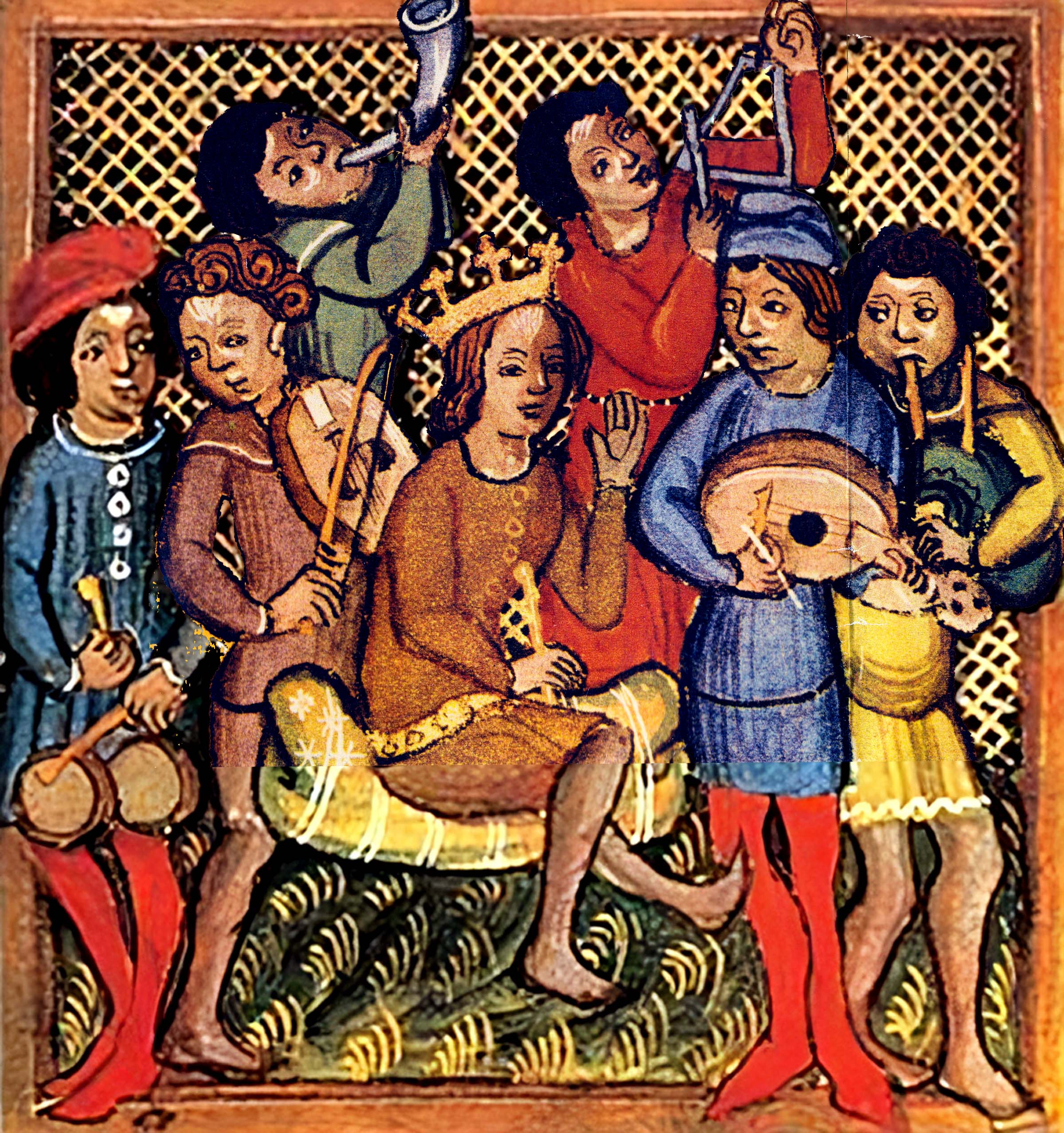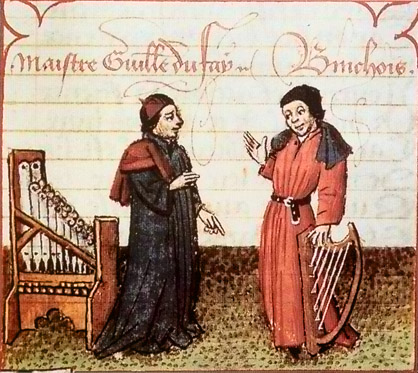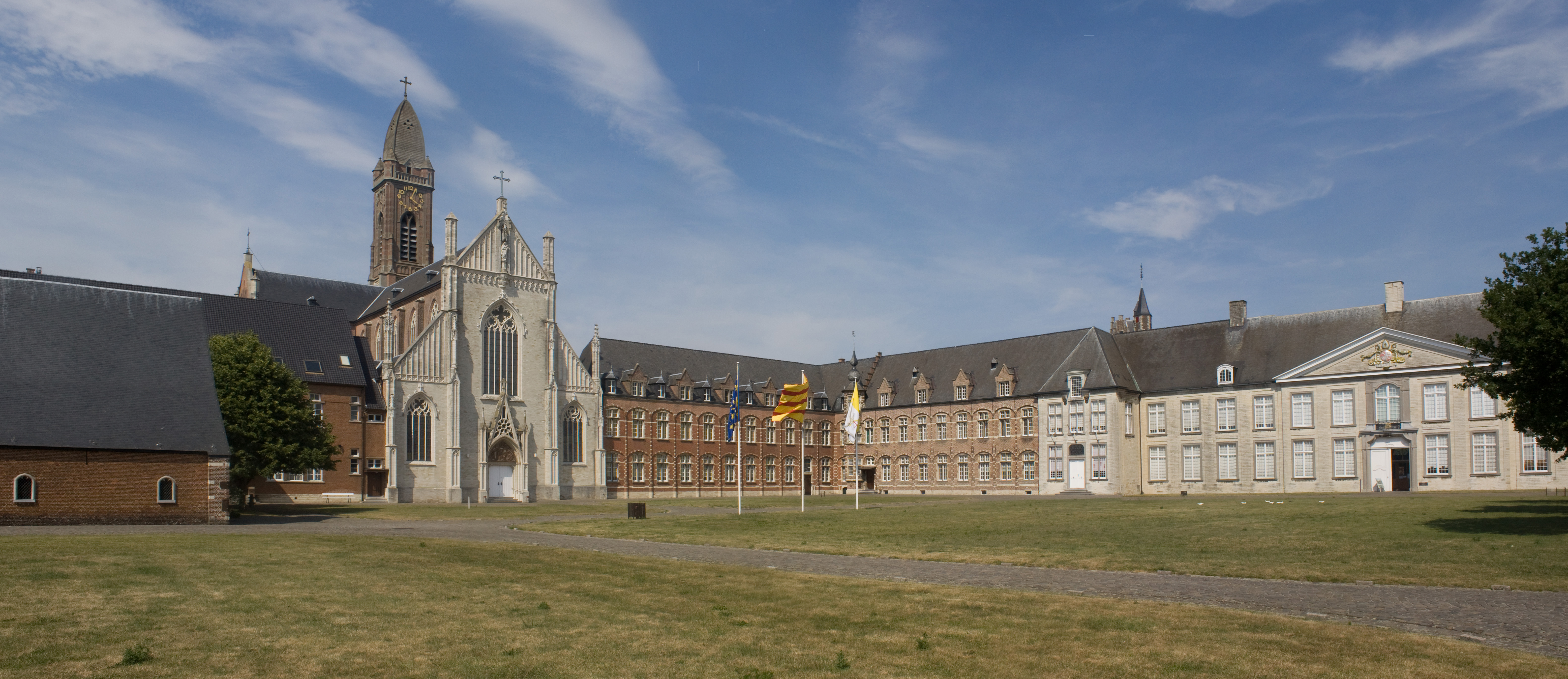|
Ensemble Für Frühe Musik Augsburg
The Ensemble für frühe Musik Augsburg is a German early music ensemble founded in 1977 and specializing in medieval music. The ensemble is regarded as "renowned" in Germany. The founding members are Hans Ganser (voice, recorder, percussion), Rainer Herpichböhm (voice, lute, gothic harp), Heinz Schwamm (voice, fiddle, bombard). In 1981 they were joined by the recorder and shawm player and singer Sabine Lutzenberger. Hans Ganser is also a noted musicologist. For example, Ganser was with Hans-Dieter Munck the first to fit one of Wolkenstein's song texts to a tune by Binchois. Ganser and Herpichböhm are also the editors of an edition of Wolkenstein's songs (1978). The ensemble's musicological work has often formed the framework for practical research into medieval and monastic music.''Analecta Praemonstratensia'' Volumes 55 to 56 Tongerloo Abbey, Belgium (Premonstratensian Abbey) 1979 Page 152 "Wertnormen als Grundkomponenten unserer geschichtlichen Existenz». Die musikalische Umr ... [...More Info...] [...Related Items...] OR: [Wikipedia] [Google] [Baidu] |
Medieval Music
Medieval music encompasses the sacred and secular music of Western Europe during the Middle Ages, from approximately the 6th to 15th centuries. It is the first and longest major era of Western classical music and followed by the Renaissance music; the two eras comprise what musicologists generally term as early music, preceding the common practice period. Following the traditional division of the Middle Ages, medieval music can be divided into Early (500–1150), High (1000–1300), and Late (1300–1400) medieval music. Medieval music includes liturgical music used for the church, and secular music, non-religious music; solely vocal music, such as Gregorian chant and choral music (music for a group of singers), solely instrumental music, and music that uses both voices and instruments (typically with the instruments accompanying the voices). Gregorian chant was sung by monks during Catholic Mass. The Mass is a reenactment of Christ's Last Supper, intended to provide a ... [...More Info...] [...Related Items...] OR: [Wikipedia] [Google] [Baidu] |
Recorder (musical Instrument)
The recorder is a family of woodwind musical instruments in the group known as ''internal duct flutes'': flutes with a whistle mouthpiece, also known as fipple flutes. A recorder can be distinguished from other duct flutes by the presence of a thumb-hole for the upper hand and seven finger-holes: three for the upper hand and four for the lower. It is the most prominent duct flute in the western classical tradition. Recorders are made in various sizes with names and compasses roughly corresponding to various vocal ranges. The sizes most commonly in use today are the soprano (also known as descant, lowest note C5), alto (also known as treble, lowest note F4), tenor (lowest note C4), and bass (lowest note F3). Recorders were traditionally constructed from wood or ivory. Modern professional instruments are almost invariably of wood, often boxwood; student and scholastic recorders are commonly of molded plastic. The recorders' internal and external proportions vary, but the bore i ... [...More Info...] [...Related Items...] OR: [Wikipedia] [Google] [Baidu] |
Lute
A lute ( or ) is any plucked string instrument with a neck and a deep round back enclosing a hollow cavity, usually with a sound hole or opening in the body. It may be either fretted or unfretted. More specifically, the term "lute" can refer to an instrument from the family of European lutes. The term also refers generally to any string instrument having the strings running in a plane parallel to the sound table (in the Hornbostel–Sachs system). The strings are attached to pegs or posts at the end of the neck, which have some type of turning mechanism to enable the player to tighten the tension on the string or loosen the tension before playing (which respectively raise or lower the pitch of a string), so that each string is tuned to a specific pitch (or note). The lute is plucked or strummed with one hand while the other hand "frets" (presses down) the strings on the neck's fingerboard. By pressing the strings on different places of the fingerboard, the player can sho ... [...More Info...] [...Related Items...] OR: [Wikipedia] [Google] [Baidu] |
Harp
The harp is a stringed musical instrument that has a number of individual strings running at an angle to its soundboard; the strings are plucked with the fingers. Harps can be made and played in various ways, standing or sitting, and in orchestras or concerts. Its most common form is triangular in shape and made of wood. Some have multiple rows of strings and pedal attachments. Ancient depictions of harps were recorded in Current-day Iraq (Mesopotamia), Iran (Persia), and Egypt, and later in India and China. By medieval times harps had spread across Europe. Harps were found across the Americas where it was a popular folk tradition in some areas. Distinct designs also emerged from the African continent. Harps have symbolic political traditions and are often used in logos, including in Ireland. History Harps have been known since antiquity in Asia, Africa, and Europe, dating back at least as early as 3000 BCE. The instrument had great popularity in Europe during the ... [...More Info...] [...Related Items...] OR: [Wikipedia] [Google] [Baidu] |
Fiddle
A fiddle is a bowed string musical instrument, most often a violin. It is a colloquial term for the violin, used by players in all genres, including classical music. Although in many cases violins and fiddles are essentially synonymous, the style of the music played may determine specific construction differences between fiddles and classical violins. For example, fiddles may optionally be set up with a bridge with a flatter arch to reduce the range of bow-arm motion needed for techniques such as the double shuffle, a form of bariolage involving rapid alternation between pairs of adjacent strings. To produce a "brighter" tone than the deep tones of gut or synthetic core strings, fiddlers often use steel strings. The fiddle is part of many traditional (folk) styles, which are typically aural traditions—taught " by ear" rather than via written music. Fiddling is the act of playing the fiddle, and fiddlers are musicians that play it. Among musical styles, fiddling tends to p ... [...More Info...] [...Related Items...] OR: [Wikipedia] [Google] [Baidu] |
Pommer
Pommer or bombard ( French ''hautbois''; Italian ''bombardo'', ''bombardone'') describes the alto, tenor, bass, and contrabass members of the shawm or Schalmey family, which are similar in function to the modern cor anglais, tenoroon, bassoon, and contrabassoon, although the bassoon family's direct ancestor was the dulcian/curtal family. Overview The name "Pommer" arose in Germany, named after artillery, and was large and powerful in tone. The shawm family was the prototypical consort instrument, built in seven sizes from high soprano to great bass, and an ensemble of double reed shawms was capable of producing a grand, full, and balanced sound. These instruments remained popular outdoor instruments and ceremonial instruments up until the development of the more refined and eloquent oboe family by the Philidors and Hotteterres in France during the middle of the 17th century. The cromorne family, not to be confused with the crumhorn, was a sort of transitional instrument that re ... [...More Info...] [...Related Items...] OR: [Wikipedia] [Google] [Baidu] |
Shawm
The shawm () is a Bore_(wind_instruments)#Conical_bore, conical bore, double-reed woodwind instrument made in Europe from the 12th century to the present day. It achieved its peak of popularity during the medieval and Renaissance periods, after which it was gradually eclipsed by the oboe family of descendant instruments in classical music. It is likely to have come to Western Europe from the Eastern Mediterranean around the time of the Crusades.The Shawm and Curtal ��from the Diabolus in Musica Guide to Early Instruments Double-reed instruments similar to the shawm were long present in Southern Europe and the East, for instance the Ancient Greek music, ancient Greek, and later Byzantine Empire#Music, Byzantine, aulos, the Persian sorna,Anthony C. Baines and Martin Kirnba ... [...More Info...] [...Related Items...] OR: [Wikipedia] [Google] [Baidu] |
Wolkenstein
Wolkenstein is a town in the district Erzgebirgskreis, in Saxony, Germany. It is situated in the Ore Mountains, on the river Zschopau, 22 km southeast of Chemnitz. The town is situated on a rocky spur near the confluence of Zschopau and Preßnitz. Its name is derived from the eponymous castle which is situated ca. 70 m above the river, and whose name signifies a rock that rises into the clouds. Aside from the town itself, Wolkenstein consists of the following subdivisions: Of these, Warmbad is a spa town known for its hot spring with a variety of medicinal uses. History A Herrschaft Wolkenstein is mentioned in 1262. The town itself was first mentioned in 1293, and was first called an "oppidum" in 1323. A school was first recorded in 1385. From 1378, Wolkenstein was the seat of the noble family of Waldenburg. After they died out in 1473, it reverted to the House of Wettin. At the same time, mining started again in the area. The Protestant Reformation was introduced ... [...More Info...] [...Related Items...] OR: [Wikipedia] [Google] [Baidu] |
Binchois
Gilles de Bins dit Binchois (also Binchoys; – 20 September 1460) was a Franco-Flemish composer of early Renaissance music. A central figure of the Burgundian School, Binchois and his colleague Guillaume Du Fay were deeply influenced by the ''contenance angloise'' style of John Dunstaple. His efforts in consolidating a 'Burgundian tradition' would be important for the formation of the Franco-Flemish School. One of the three most famous composers of the early 15th century, Binchois is often ranked behind Du Fay and Dunstable by contemporary scholars, but his works were still widely cited, emulated and used as source material after his death. Described by the musicologist Anthony Pryer as a "supreme miniaturist", he generally avoided large scale works, and is most admired for his shorter secular chansons. Despite this, it is thought that considerably more of his sacred music survives than secular music, creating a 'paradoxical image' of the composer. Reflecting on his style, the ... [...More Info...] [...Related Items...] OR: [Wikipedia] [Google] [Baidu] |
Tongerloo Abbey
Tongerlo Abbey is a Premonstratensian monastery at Tongerlo in Westerlo near Antwerp, Belgium. History It was founded in 1128 in honour of the Blessed Virgin Mary, by Giselbert of Kasterlee, who not only gave the land, but also himself became a lay brother in the new community. The first monks were sent from St. Michael's Abbey, Antwerp, under Henry, who had come with Saint Norbert, founder of the Premonstratensian Order, to Antwerp to extirpate the Tanchelmite heresies. The charter of its foundation was signed, amongst others, by Bernard of Clairvaux and by Waltman, first abbot of Antwerp. The Bishop of Cambrai granted synodal rights to the abbots. From small beginnings the abbey became influential in the district called Campine, now in north-east Belgium and the south of the Netherlands, then a wild area. The bishops of Cambrai, the chapters of Liège and Maastricht, and several landowners entrusted the charge of parishes, with the right of patronage, to the abbey. In time the a ... [...More Info...] [...Related Items...] OR: [Wikipedia] [Google] [Baidu] |
Christophorus Records
Christophorus Records is a German classical music label based originally in Freiburg im Breisgau specializing in Catholic church and early music. History The history of the Herder family in publishing in Freiburg goes back to Bartholomä Herder (1774–1839) ''Fürstbischöflicher Hofbuchhändler und Hofbuchdrucker'' in 1801. The publishing house of Herder still exists. The Christian book publishers Christophorus-Verlag Herder KG. was founded by Hermann Herder und Dr. Josef Knecht in 1935 as a passive resistance to developments in religion in Nazi Germany.„Der Verlag Herder 1801–2001. Christophorus Schallplatten began as a part of the picture book division of Christophorus Verlag in 1939. The record label is now distributed by Musicontact GmbH, Heidelberg. Artists Among the artists who have regularly recorded for the label are Ensemble für frühe Musik Augsburg, Johann Rosenmüller Ensemble The Johann Rosenmüller Ensemble is a German early music group formed by the Germa ... [...More Info...] [...Related Items...] OR: [Wikipedia] [Google] [Baidu] |
Oswald Von Wolkenstein
Oswald von Wolkenstein (1376 or 1377 in Pfalzen – August 2, 1445, in Meran) was a poet, composer and diplomat. In his diplomatic capacity, he traveled through much of Europe to as far as Georgia (as recounted in "Durch Barbarei, Arabia"). He was dubbed a Knight of the Holy Sepulchre and was also inducted into the Order of the Jar and the Order of the Dragon. He lived for a time in Seis am Schlern. Life Oswald's father was Friedrich von Wolkenstein and his mother was Katharina von Villanders. When he was ten years old, Oswald left his family and became a squire of a knight errant. Oswald described the journeys undertaken by him in the following 14 years in his autobiographical song "Es fügt sich...". He mentioned his travels to Crete, Prussia, Lithuania, Crimea, Turkey, the Holy Land, France, Lombardy (i.e. what is known today as Northern Italy) and Spain, as well as being shipwrecked in the Black Sea. After the death of his father in 1399, Oswald returned to the County of Tyr ... [...More Info...] [...Related Items...] OR: [Wikipedia] [Google] [Baidu] |






